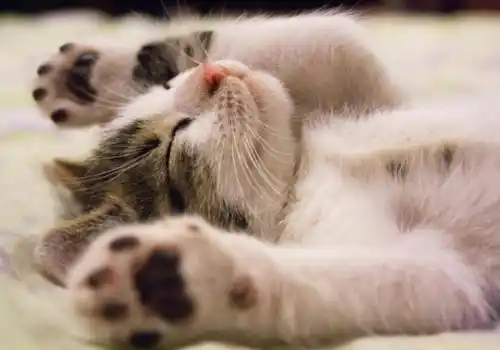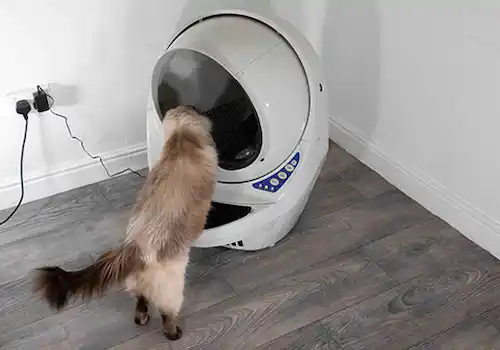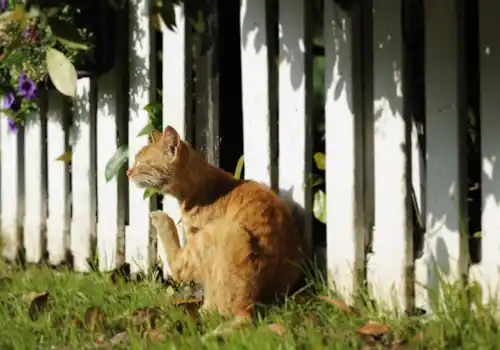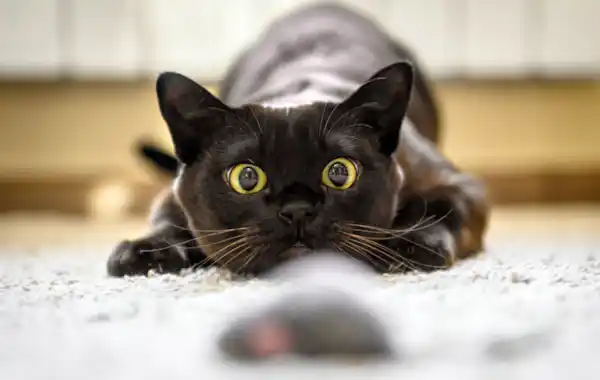To maximise the chances of getting your cat to engage with his toys the following criteria should feature in your decision making: the size of the toy, its similarity to prey, its texture, its weight, and whether or not your cat has been previously exposed to something similar.
Does size matter?
In terms of size and weight of a toy, it’s a good idea to think about the size of your own cat. Is he a feline colossus or a petite pussycat? Big toys, such as the cat kicker, are usually robust enough to withstand the full force of a larger cat but might be too big for smaller cats. Having said that, tiny little kittens will often happily play with big toys so there isn’t always a connection between the size of a toy and the size of a cat, but it is something worth considering. When it comes to small toys though, most cats no matter what their size, seem to like the fact that once they have ‘killed’ it, they can proudly pick it up in their mouth and carry it off somewhere.
 KONG Kickeroo Cuddler Catnip Cat Toy
KONG Kickeroo Cuddler Catnip Cat Toy
This unique toy appeals to a cat’s instinctive desire to stalk and capture prey. The KONG Kickeroo Cuddler’s enticing burlap fabric brings scratching adventure to a whole new level.
Three different textures excite and offer fun games of bat and roll and cuddle time. Infused with irresistible KONG Premium North American catnip, a fluffy tail and stimulating crinkles will delight offering an added reward.
BUY NOW
Cat toy texture
As for texture, toys made from feathers and fur (real or faux) are ideal as they most closely resemble a cat’s prey. It's also important to choose some toys that disintegrate or change when your cat plays with them. Shredding prey is one of the stages of the predatory sequence so any damage that your cat can inflict on a toy will add an extra element of fulfillment. And I’m sure you’d prefer your cat be doing this to a toy on your carpet, rather than to the real thing.
Feather and fur cat toys
VioVet offers a wide selection of cat and kitten toys, including tunnels, balls and interactive boredom busters.
BUY NOW
While having a selection of toys that look and feel like mice and birds is recommended, in most homes there is an inordinate number of everyday items that cats are happy to play with, anything from straws to screwed up paper, corks, and any small ball. These can keep your cat well and truly entertained at no cost to you at all.
Smelly cat toys
No toy box would be complete without some toys that provide your cat with scent enrichment. These include toys made with catnip, valerian, silvervine, and Tatarian honeysuckle wood. These all contain compounds that cats can go a bit loony over, but not all. For example, whether or not a cat responds to catnip is genetically determined and the only way you’ll find out if your cat is one of the one in three that doesn’t respond is to try it out on him. If it’s a no-go, then you’ve got the other plants up your sleeve. And even if he does go ga-ga over catnip, exposing him to the scents of the other plants will give him a lovely natural variety of smelly toys to play with.
Catnip cat toys
VioVet offers a range of catnip cat toys - designed to provide your cat with plenty of entertainment.
BUY NOW
Electronic cat toys
These days technological advances extend to the cat toy market and there are now lots of toys around that can help keep your cat occupied either when you’re out or just not in a position to acquiesce to his demand for play at any given time. These range from motion activated toys, battery-operated toys and digital toys, to those that an owner can control via a smartphone.
Motion activated toys have a built-in sensor that wakes the toy up when movement near it is detected. I’ve seen a lovely example that has a butterfly attachment which moves around and which can be pounced on! I’ve also seen similar toys that use a moving laser beam, but while this might engage your cat, not being able to catch anything can cause frustration.
I’ve seen the same type of thing available as a ‘smart’ cat toy. So rather than the unit being motion activated, it is controlled by an app on your phone. Both these types are a good option for owners who spend long periods out of the house.
There are also some really good battery-operated toys, such as those where a mouse moves erratically under a mat, or a furry mole peeks from one of any number of holes in the base unit.
Digital games are represented by the enormous number of videos for cats that now populate the internet. These are free and can be a great way to distract your cat but viewing should be curtailed if your cat starts to display any signs of frustration at not being able to get whatever’s on the screen. Overall, I would say that it’s definitely worth having one or two of this type of toy in your armoury.
Word of warning
A word of caution about any toys you choose. Make sure that parts that can be bitten off and ingested are removed before giving the toy to your cat. Likewise, avoid leaving any string or rod toys out where your cat could get caught up in them. If you use paper bags ensure any handles are removed.
Something else for us to think about is that when it comes to real prey, cats tend to have specific preferences. So, if you have a cat that always brings home mice then it’s likely that he’s going to respond to small furry toys, both in physical and digital form. However, this doesn’t mean you should limit the toys you provide your cat with to this type — it’s important that he is able to experience a variety.
For all cats, my advice would be to provide a selection of toys, big, small, furry, feathered (as well as other textures), shreddable, chase-able, smelly, and electronic, and offer them one at a time to find out which your cat is attracted to.
Advice provided by expert behaviourist Clare Hemington







